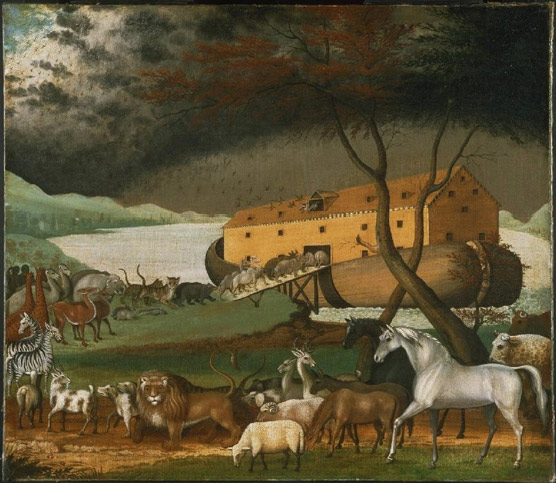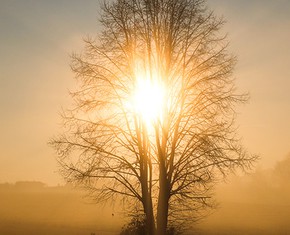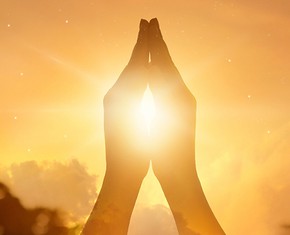The views expressed in our content reflect individual perspectives and do not represent the authoritative views of the Baha'i Faith.
And the Lord said unto Noah, Come thou and all thy house into the ark; for thee have I seen righteous before me in this generation. – Genesis 7:1.
I do set my bow in the cloud, and it shall be for a token of a covenant between me and the earth. And it shall come to pass, when I bring a cloud over the earth, that the bow shall be seen in the cloud: And I will remember my covenant, which is between me and you and every living creature of all flesh; and the waters shall no more become a flood to destroy all flesh. – Genesis 9:13-15.
Praise be to God that the teachings of God are revoiced, the light of reality has dawned again, the effulgence is increasing daily, and the radiance is shining more gloriously in the zenith. From the cloud of mercy a deluge is descending; the Sun of Reality is brilliant in its eternal station. – Abdu’l-Baha, The Promulgation of Universal Peace, p. 51.
We all know the story of Noah’s Ark—but do you know what it really means?
 Contained in Genesis, chapters 6 through 9, the story recounts a Great Flood, sent by God to scour the Earth of perfidy and corruption. Familiar to Jews, Christians and Muslims (the Qur’an calls the Ark Safina Nuh, or Noah’s boat), this classic motif doesn’t only occur in the Abrahamic religions—it runs through just about every human culture and Faith.
Contained in Genesis, chapters 6 through 9, the story recounts a Great Flood, sent by God to scour the Earth of perfidy and corruption. Familiar to Jews, Christians and Muslims (the Qur’an calls the Ark Safina Nuh, or Noah’s boat), this classic motif doesn’t only occur in the Abrahamic religions—it runs through just about every human culture and Faith.
Called a deluge or flood myth, it usually hinges on a deity’s destruction of civilization as an act of divine retribution, and the re-making and renewal of the Earth and its inhabitants in the process.
Probably the oldest known deluge myth comes from the Sumerian culture, in its Epic of Ziusudra, which originated in 17th Century BC Babylon. Mentions of Ziusudra and his flood in Sumerian literature predate Judaism by hundreds of years. But the lore, customs and written histories of many other cultures have deluge myths, too—the K’iche’ and Mayan peoples in ancient Mesoamerica, the indigenous Cañari Confederation in South America, the Lac Courte Oreilles Ojibwa tribe of the Anishinabe people in North America, the Hindu Puranas, Greek and Roman mythology, and many more. All of those narratives feature a great flood sent by God, and a prophet or “culture hero” who saves people and animals for the new, post-deluge era.
You might think that such a widespread myth has some actual historical evidence to back it up, but multiple scientific investigations, conducted over many successive generations, have never produced any evidence of a global deluge, or any trace of an Ark.
Perhaps, then, these ubiquitous deluge myths signify something more, something deeply symbolic meant to inspire and educate us.
The Baha’i teachings indicate that the Ark riding the waves of a deluge refers directly to the coming of a new prophet of God, and the new principles and laws that prophet brings. Symbolically, the flood washes away the broken traces of the old religious dispensation; and remakes the Earth for the appearance of the new one, just as the spring rains and floods inundate the land and sweep the detritus of winter out to sea. As a symbol of God’s teachings and covenant, the Ark represents the salvation of the people in each era, and appears throughout the Baha’i writings, used in many different ways. Here, Baha’u’llah uses the symbol of the ark to stand for divine guidance, and guiding star in the heavens to stand for the dawning of a new light in that “true and exalted Morn:”
And now, concerning His words: “And then shall appear the sign of the Son of man in heaven.” By these words it is meant that when the sun of the heavenly teachings hath been eclipsed, the stars of the divinely-established laws have fallen, and the moon of true knowledge — the educator of mankind — hath been obscured; when the standards of guidance and felicity have been reversed, and the morn of truth and righteousness hath sunk in night, then shall the sign of the Son of man appear in heaven. By “heaven” is meant the visible heaven, inasmuch as when the hour draweth nigh on which the Day-star of the heaven of justice shall be made manifest, and the Ark of divine guidance shall sail upon the sea of glory, a star will appear in the heaven, heralding unto its people the advent of that most great light. In like manner, in the invisible heaven a star shall be made manifest who, unto the peoples of the earth, shall act as a harbinger of the break of that true and exalted Morn. – Baha’u’llah, The Book of Certitude, pp. 61-62.
An ark, then, stands for a protective vessel, a container of new laws and new life, intended to survive the greatest calamities and guard its passengers from spiritual harm, threat and extinction. Each new religious revelation gives us an Ark and a covenant.
Today, the most recent of those revelations, the Baha’i Faith, offers humanity a very strong spiritual covenant, built to withstand the onslaught of the material world, and protect this new Faith from disunity and schism. That covenant has kept the Baha’is unified and sustained for almost two centuries now. It prevents the sectarianism that has plagued the Faiths of old; outlaws the bigotry and prejudice that separates us from other religions, races and cultures; and allows the Baha’i teachings to remain faithful to the vision of their prophet and founder Baha’u’llah:
…humanity, having forsaken the one essential and fundamental reality which underlies the religion of God, and holding blindly to imitations of ancestral forms and interpretations of belief, is separated and divided in the strife, contention and bigotry of various sects and religious factions. If all should be true to the original reality of the Prophet and His teaching, the peoples and nations of the world would become unified, and these differences which cause separation would be lost sight of. To accomplish this great and needful unity in reality, Baha’u’llah appeared in the Orient and renewed the foundations of the divine teachings. – Abdu’l-Baha, The Promulgation of Universal Peace, p. 315.
















Comments
Sign in or create an account
Continue with Googleor